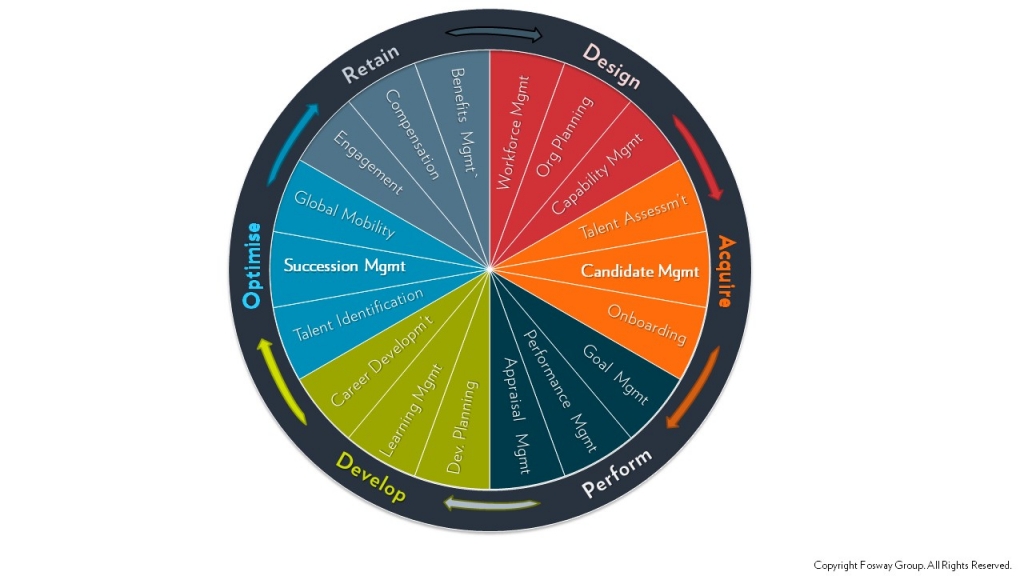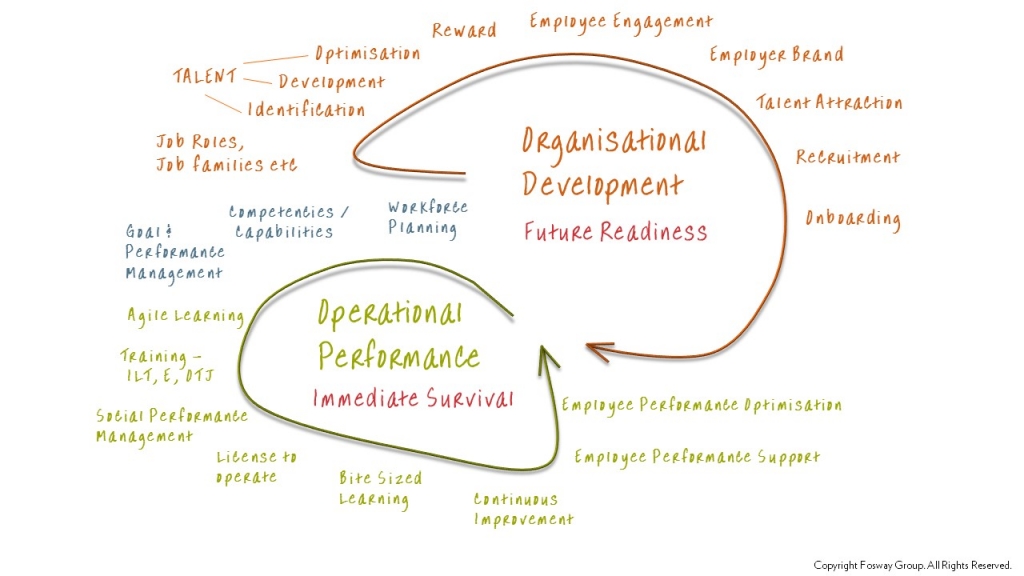Article
Talent Management: What’s learning’s role and why L&D need to fight their corner.
If you read any business magazine or report on competing and winning in business today – somewhere near the beginning they will bring up the issue of talent or talent management. Whilst talent management is a topic that the HR industry has focused on for some time, it is also becoming a topic of the boardroom. CEOs and the executive leadership in major companies now routinely talk about the ‘war for talent’, and about the need to find and retain the best people.
But seldom do we see many learning and development departments taking a leading role. L&D is all too often seen as just another segment in the overall talent lifecycle. The problem is that this couldn’t be further from the truth. Far from being a side show in the talent cycle, or just another segment, learning and development is the bed-rock, not only of many of the other talent management processes, but also for generating positive talent momentum. In many ways, learning and development is the ‘Engine Room’ of an integrated talent strategy.
That’s because learning touches, and is therefore the driver behind, nearly all parts of the talent cycle. Learning is actually a core enabler for delivering many of the other talent processes, whether others like it or not. For example:
- Learning via induction is critical to on-boarding new recruits and reducing time to competency
- Learning opportunity is a critical factor in employee engagement and retention
- Learning is a key tool for raising performance
- Learning is core to developing existing staff and building future skills
- Learning is central to individual career advancement and for building organisational capability
- Learning is key to ensuring your people are capable and compliant
The question is – given the value of learning – why do so many L&D departments have only a minor role in the talent management cycle – more of a willing contributor rather than a leader?
Partly that’s because of the nature of talent agendas. In Europe, our research shows that the ‘talent’ is not ‘all staff’, as it purports to be in the US. Talent this side of the Atlantic often means a specially selected subset of executives and senior leaders, high performers, graduate in-takes and fast-track specialist roles, which could be referred to as ‘critical talent’.
This often means that talent management, in many European organisations, is often not a suite of connected processes, but a fragmented landscape of disconnected talent silos, operating under an aggregating HR function. They function separately, and use different systems and data not integrated with learning and development.
In some ways this is also because for many organisations, despite the management rhetoric, Learning has never truly been a strategic tool. This lack of a strategic identity in L&D is potentially holding it back from taking a more impactful role in strategic talent development.
But, given the increasing importance of talent management to the business agenda, the time is now ripe for L&D departments to make a much more vocal and visible lead contribution to talent management in their organisations. For all companies, their people really are one of the biggest assets in the modern business, and ultimately people are the source of most of their real differentiators in the market.
It is inevitable that greater attention will be focused on strategic talent management. Attracting, developing and retaining people talent is already important but will become even more business critical as the need to recruit and retain high calibre people gets stronger and stronger. With the beginning of an up-turn in the UK economy, there is a growing impetus for people to look to new career opportunities and more organisations are now actively recruiting. The risks for those without truly effective talent management and development strategies in place is that they face the triple whammy of not only losing their best people, but also not having the people to replace them, or the employer brand or reputation to attract the best new candidates.
When we look at the ‘how’ of talent management, we find that learning and development is one of the central elements of the employee value proposition for attracting and retaining key talent, as well as being the central pillar of talent development. Whether it is about on-boarding new team members faster and more effectively, raising current business productivity and performance, filling current skills gaps, or by the development of strategic capabilities to succeed in the future, learning is key.
So whilst learning and development is often perceived as a junior partner in the overall HR hierarchy, there’s never actually been a better time for L&D to recognise their wider role. But to make this happen, L&D professionals need to start re-calibrating what they do in the talent management space. And they also need to be more much vocal and proactive in positioning where and how they can start to strategically shape talent, not only so their organisations can succeed today, but also to succeed tomorrow.
In learning technology the impact of this wider talent orientated view is becoming more visible. In particular it’s becoming a consistent feature of organisations buying decisions behind their LMS and other learning systems. Frequently the learning departments is one of many voices behind what platforms are used to manage corporate learning.
The need to link capability, performance, compliance and development planning, succession and talent pools is now such an established part of the HR agenda that the learning department is frequently not solely in control of the selection of learning solutions and solution decisions. HR transformation programmes, and strong HR leadership are looking to offer employees and their businesses a strong HR proposition of joined up talent management processes. Most obviously in the optimisation of internal talent. That’s to say – having the best people, in the right roles being the best they can be.
Practically this means having a coherent and single view of organisational skills, knowledge expertise – frequently referred to as capability. For example, if you are a global services provider and you want to build the best global project team, you need a global view of that talent pool, their skills, depth of understanding, licenses to operate with different products, qualifications to work in different regulations across different geographies, as well as their performance ratings in their previous assignments.
Whilst this might seems like simply a resourcing issue, actually it bites much deeper. Simply because the opportunity to offer global mobility to employees can be a massive attraction for the best talent in and outside your organisation. It becomes a visible aspect of employee brand… and that in its own right has a massive impact on attracting the right employees to your company in the first place.
It’s this desire to have a joined up story, on this and many other HR opportunities, that is at the root of many learning technology decisions that we see in larger corporates. And this in turn is taking the corporate decision for what learning systems an organisation should have, more and more, out of the learning department and pushing the controlling decisions not to learning leaders but to leaders of HR transformation.
This movement has been recognised by the vendors themselves for a long time and especially in the Learning Management Systems space. It is difficult to find enterprise class LMS provider who hasn’t already broadened their solution offering to include at least include some elements of performance and succession management. The evolution of players like SuccessFactors, Cornerstone and IBM demonstrate this pressure to diversify either by broadening their suite or being a target of acquisition from the HR providers. But the dash for joined up talent management may yet be overtaken by the dash for unified Human Capital Management systems – especially in larger corporates. Companies like Workday, innovators in the Cloud HCM space have recently announced they are building modules to support learning, albeit it’s still too early to understand the scope and sophistication. But it’s this sort of evolution that is likely to create even greater challenges for the learning team to have a standalone learning architecture. And the pressures to operate in a more integrated talent suite have a strong momentum.
However, this move to consolidation is not the only trend at play, and learning agenda is not only being driven by the HR view of strategic learning and talent. There are other practical– dare I say – an operational / business view of learning that is pulling systems decisions – occasionally in completely different directions.
In this context it’s not the story of talent, but the pragmatic drivers of new systems, new starters, compliance, and new processes driven by organisational change that come into play. An immediate learning agenda that is often short-term but essential for organisations’ day to day survival.
In this world of operational performance, long term capability is not as important as immediate high performance actions. In this operational world, agility and performance support are as, if not more crucial than learning courses. Rapid cycles of performance feedback are often more important than performance appraisal processes. Immediacy and capturing continuous improvement are more critical than managing learning for collaborative cohorts.
What makes this operational approach so important from a technology standpoint is that it can drive very different requirements, and therefore very different selection criteria, behind organisations learning architecture. This in turn creates drivers for very different systems and can be a real point of tension, even fragmenting learning into solutions that support talent development and those that facilitate operational business projects.
This means that, just as the forces behind the talent view of learning system and consolidation are reaching their strongest, there are already disruptive forces at play – counter to the vision of unified talent systems. Not because the organisational development view is wrong, but because occasionally the systems that support it are not sophisticated enough to support the challenges of agile learning required by operational projects – especially in the field of performance support. As a result, we are seeing pressures for more targeted learning solutions – for example focused on retail sales.
And therein lays the crux of the issue. L&D are struggling to serve two masters. And unfortunately too few learning solutions are equally good at serving the needs of longer term organisational development and agile operational performance improvement.
So, looking back to the growing pressure for a strategic view of learning linked to talent. It is not a simple as some might make it sound.
One problem is, that as the decision making for integrated talent based approaches grow, the systems decisions tends to move away from the learning team to the talent / HR transformation team. But, as it does so the understanding of what is practically needed by operational business pressures also starts to diminish. And that is why L&D’s role is so very important and why L&D need to take a proactive role in the talent management debate.
Because to succeed, organisations need to have a vision for both the organisational (talent) development and the operational performance. In many cases L&D are the only part of HR that understands the operational learning. And L&D are perfectly placed to argue for both sides. But, all too often, L&D lack the insight into talent management to be as vocal as they should be, in arguing for both agendas.
That needs to change and change quickly. It’s time for L&D to have a strategic vision for talent management and operational learning! Without it, L&D and your business, are missing some massive opportunities.
This article, written by Fosway’s Director of Research, David Perring, first appeared in Inside Learning Technologies magazine.
[related_posts_by_tax taxonomies=”category,post_tag”]



